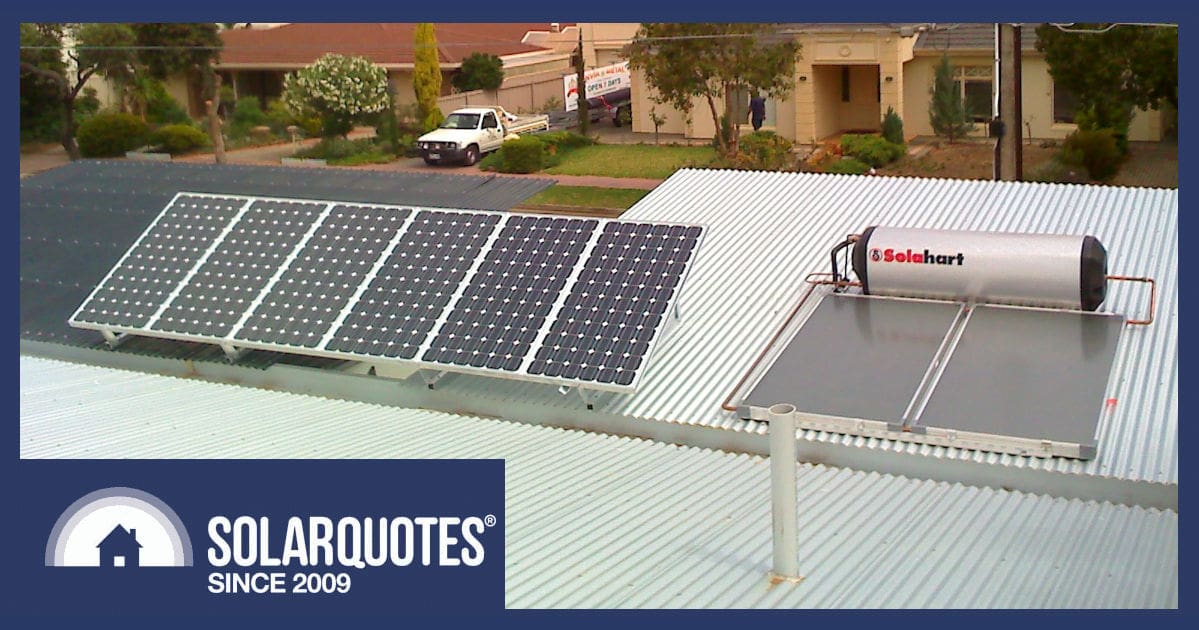
If you’re replacing a small system with a bigger and better one, what does an ethical way to dispose of your old equipment look like? Read on while we detail a couple of ways old solar can still lead a useful life.
Realistically speaking, used solar equipment is nigh on worthless in Australia due in equal parts to first-world labour rates and the STC incentive scheme, which effectively puts new glass on your roof for free.
We’ve detailed it before, but if you have to remove a solar power system, it’s often better to replace it with a new one than to reinstall legacy technology.
Gumtree Geezers Beware
Remember paying $12,000 for your one-kilowatt, six-panel solar power system? You’ll need to subtract two zeros for a quick secondhand sale. It’s increasingly rare that people need like-for-like replacements, so inverters get scrapped, sadly, for cents per kilogram.
Panels may be worth more depending on age. Some people offer $10 or $20 each for any old modules. They are packed roughly in shipping containers and sent to developing countries.
Though this can be a great reuse of resources, it has also been argued that it is just dumping e-waste on people ill-equipped to recycle it properly. New panel prices are getting so low that it’s hardly worth shipping them now.
Newer modules retired from bigger systems are of some value to off-grid type applications. The 20 panel, 5 kilowatt systems that are too modest for a modern house these days can actually make grand battery charging systems for a weekend campsite or low-budget tiny home.
Solar Depreciation Is Worse Than Luxury Cars
A bloke I know bought a new Aston Martin a few years back, with complimentary flights to England, so he could watch them build it.
Amazing the trinkets you get when the trade-in value for your low mileage, supercharged V8 Jaguar means you burnt $145,000 in four years. My heart bleeds for him when he complains it’s too shady for solar at his house.
With rules changing continually, solar technology moves faster than any performance car.
Connection approvals, updated Australian and IEC international standards, warranty rules, plus the need for skilled labour to make installation compliant means new solar panels are hard to give away once they’ve been screwed to a roof.
Even Electricians Pay Solar Installers
Electricians all understand the wiring rules (AS3000) but industrial, mining, process control, line work, or domestic house bashing are all crafts of their own. They call for different standards, meaning qualified electricians will seek out help for specialties they’re not tooled up to work with.
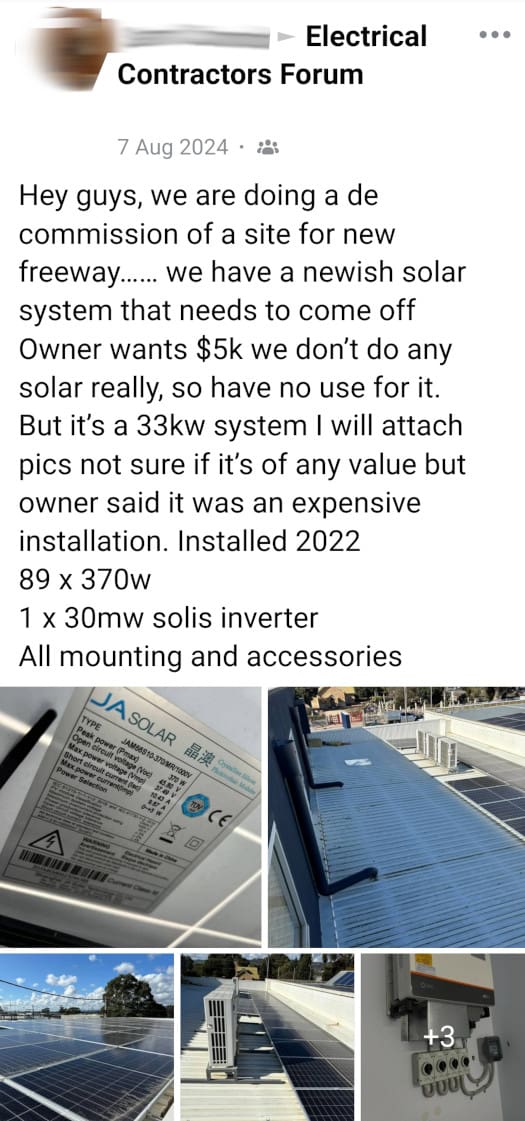
Posted recently on one of my professional groups. It’s a great example of a budget system being oversold by an end user, and an electrician confusing Megawatts with Kilowatts.
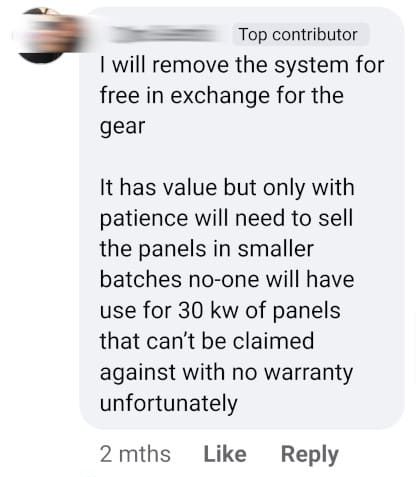
A qualified & insured local solar installer making a well-reasoned offer to professionally remove a system & cart it away. He was happy not to win it.
The punter who bought this asset above should be aware that it can still cost real money to reinstall legally.
Electrical work over 50 volts AC or 120 volts DC must be undertaken by qualified people.
DIY enthusiasts won’t get insurance for their houses if they’re working above these thresholds, but as we’ve written before, a campervan can be a good learning experience. Even those contemplating a tiny house could skirt the rules legally.
For charging a 48 volt battery, wiring this monster array up in 44 pairs of panels might technically work. That would be a ludicrous arrangement if you’re aiming for 30kW of solar though.
Where originally this system was 4 strings and one inverter, for 44 strings you’d need no less than six Victron 150/100 MPPT regulators.
At $700 each, that’s $4200 before you’ve bought 88 fuses, 88 plugs or a single metre of cable. A classic case of why DIY isn’t cheap.
Old Solar Is Great For Little Jobs
Small solar panels are poisonously expensive and often poor quality. You can pay $7 per watt if you’re mad enough.
Whereas an old 200watt panel for $20 equates to 10 cents per watt, so if you have the physical space there’s no reason why your pond pump, electric gate opener, stock fence energiser or garden lights don’t deserve a panel with 10 times the capacity you need.
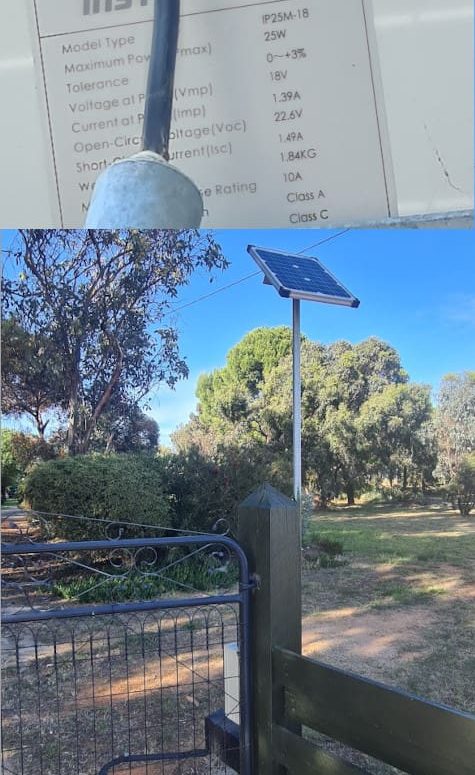
A typical solar powered gate opener with 22VOC panel
Control Is Essential
Most rooftop solar panels put out around 45v or 38v: that’ll literally cook a battery if it’s not regulated.
Pulse Width Modulation (PWM) is a basic type, but better units use Maximum Power Point Tracking (MPPT).
While an MPPT is more expensive, it will cope with 45 volts input and 14 volts output without drastically cutting the conversion efficiency.
Take Note. The key specification to take note of is the Open Circuit Voltage (VOC) of the panel, to ensure it doesn’t exceed the rated input for the regulator.
If you are looking at cheap regulators/charge controllers on eBay, and the VOC specification is vague or hard to find, don’t buy it.
Something like the Victron unit pictured below will cope with 55VOC, but even with reputable brands, the fine print explains it’s only suitable for 24v batteries if you’re using a 38+VOC household solar panel.
This demonstrates the problem with PWM-type regulators: they work simply by switching on and off for a fraction of a second. Even though it’s fast, repeatedly exposing the battery to full panel voltage is still quite rough and will shorten the life of the battery.
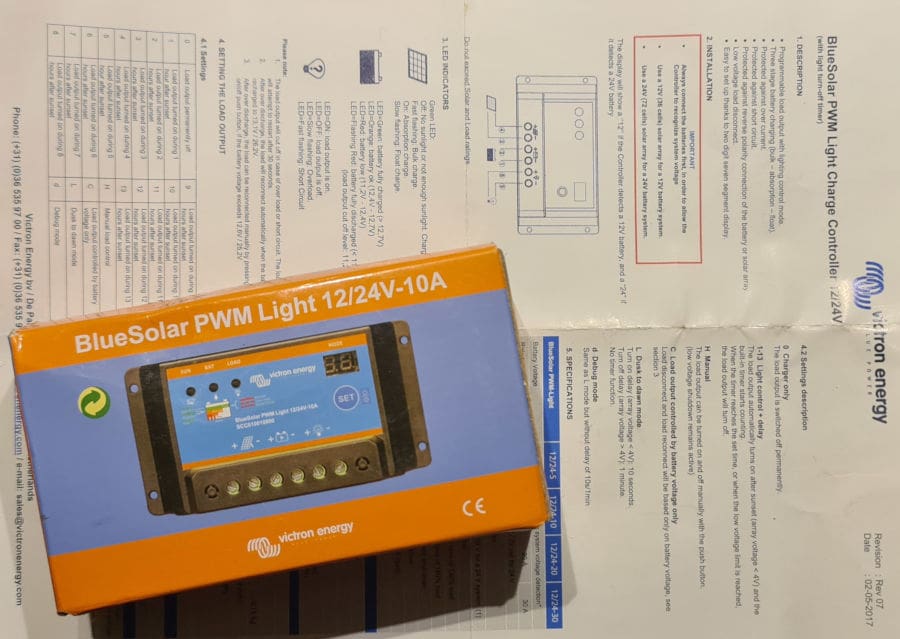
Victron BlueSolar PWM Light 12/24v-10a will handle most single domestic solar panels.
A decent and durable solution needs something like a Victron SmartSolar MPPT 75/15. There’s an online calculator to choose one.
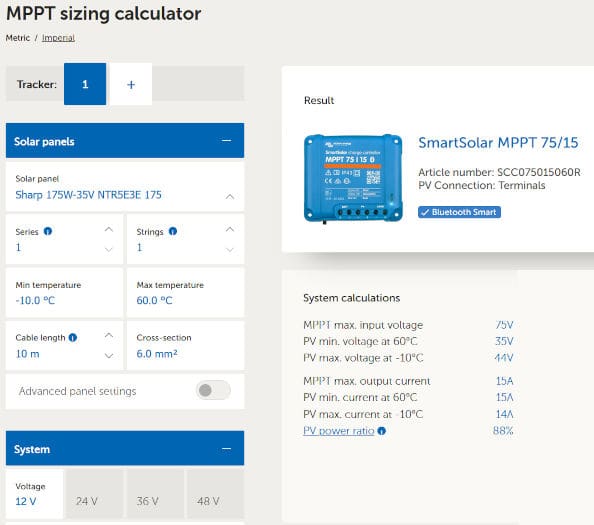
Put a panel brand and wattage into this widget and it’ll help select hardware.
Better yet, with this unit you can pull up nearby and check the system is working via Bluetooth without needing a meter, screwdriver or screen.
A Word Of Warning
If you find some old solar panels that are sort-of uniform mahogany-brown colour, made by Kaneka, Mitsubishi, Schott or others, they could be thin-film solar panels.
They offer about half the wattage per square metre of a crystalline solar panel and very high open circuit voltage, which sadly means they’re not good for much, especially battery charging.
For instance a 100w Mitsubishi thin film is 1.4 x 1.1 metres, putting out 0.9amps at 110VOC ie 65watts/m².
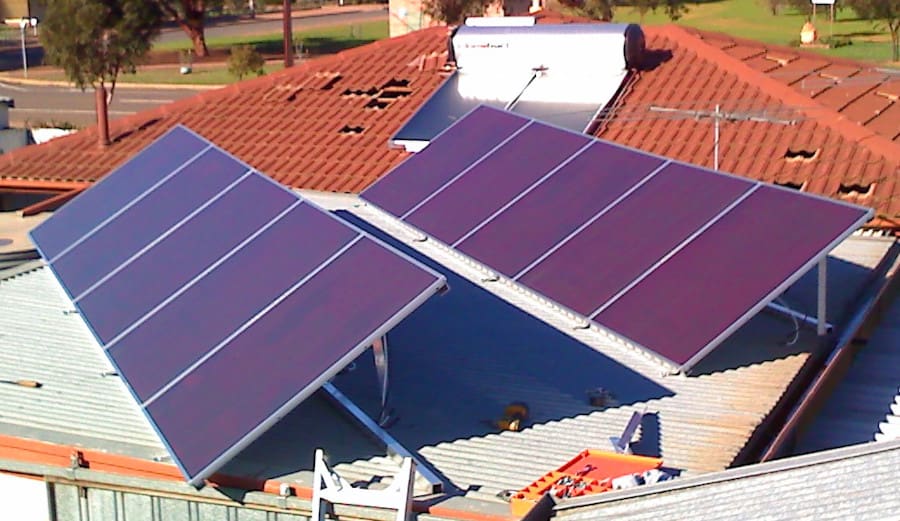
1kW of Mitsubishi thin films. 2008:05:28 13:43:52
A contemporary Sharp 175w crystalline panel is typically 1.6 x 0.8 metres, putting out nearly 5amps at 44VOC, ie 136w/m².
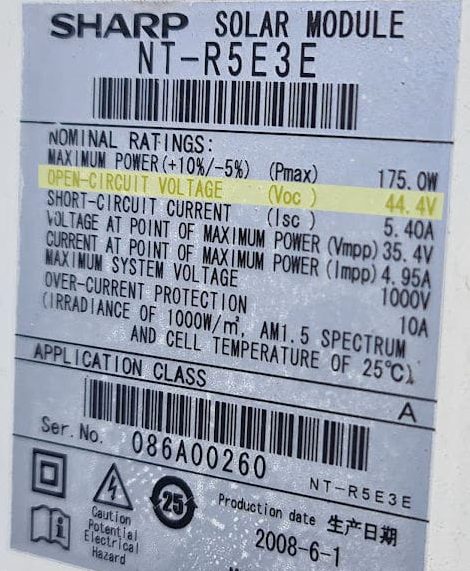
I love the fact Sharp would date the panels they make.
Two wires from the solar panel to the regulator which is hiding under that green cover, then two more wires to the battery (preferably with a fuse in line), is about as simple as it gets.
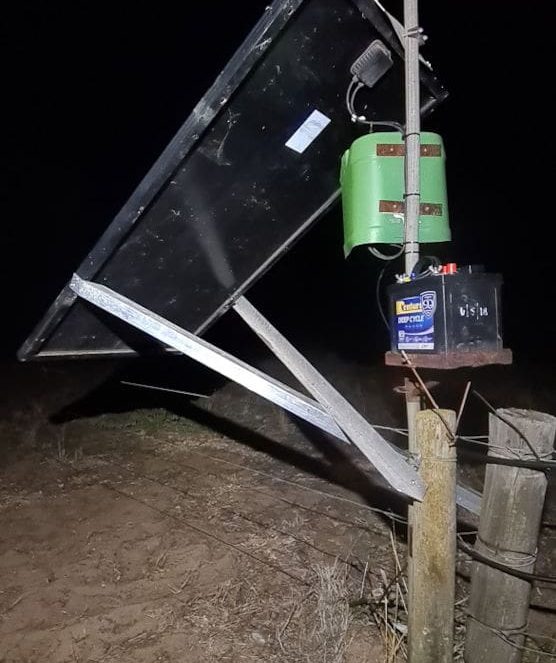
An all-black 200watt panel cobbled up to a couple of fence posts.
This closeup shows why clean connections are essential. A stock fence energiser turns 12 volts from a battery into short pulses of 7500 volts!
Although the current is tiny, it’s able to bridge gaps and slowly gouge out poor connections like this one. On the 12-volt supply side, this connection would have stopped working years ago.
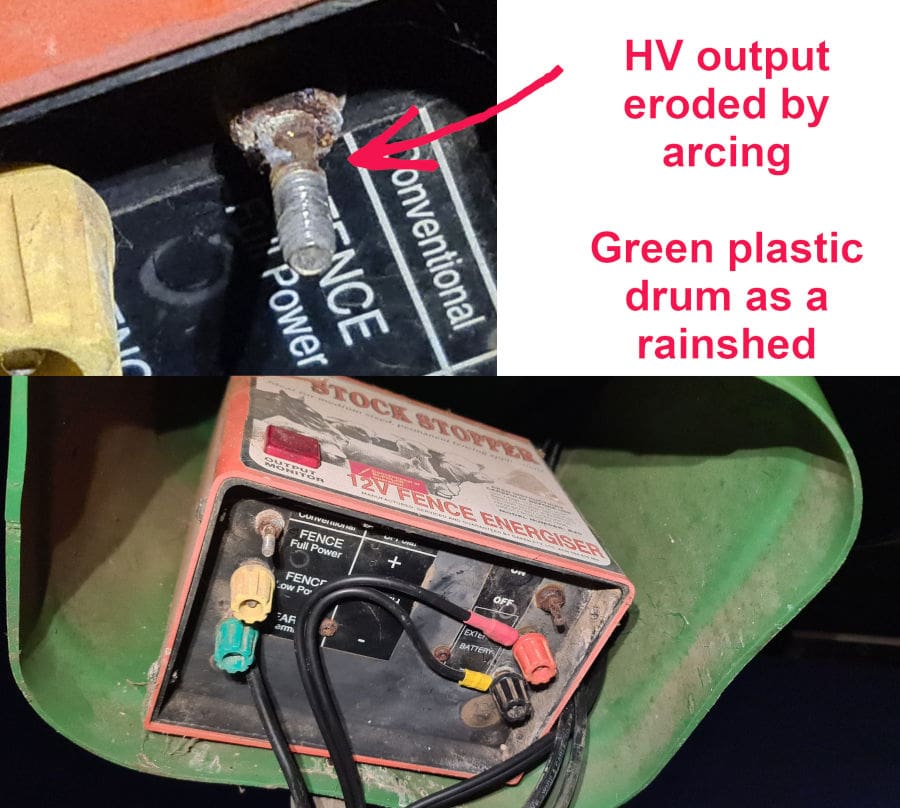
Farming involves many skills, like engineering weatherproof enclosures and diagnosing burnt electrical connections.
There are plenty of guides available on how to size and connect a solar panel to charge a battery. If you can identify the dangerous end of a screwdriver and tell red from black, there’s a good chance you can make this example above work at your place.
Stay tuned. If I can raid the SolarQuotes kitty, we’ll do a quick step-by-step demonstration of how to do it.

 RSS - Posts
RSS - Posts


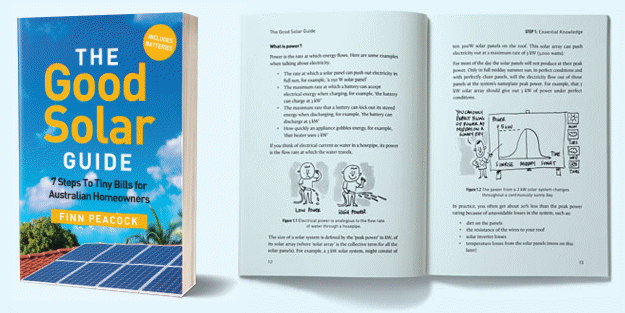
Those Thin film panels work well in Low light. But one thing not mentioned about them is I think they are toxic waste.
> 1 X 30mw Solis inverter
> an electrician confusing Megawatts with Kilowatts.
mw… They could also be confusing milliwatts with kW, for a seriously undersized, rather than oversized, inverter 😉
When I had to have our ten year old panels moved, so that I could build an upstairs extension, I was annoyed to find that they could not be reinstalled. They were guaranteed for 20 years, but the importer failed to keep their registration current. And you are not allowed to install unregistered panels.
It is environmentally undesirable to throw away perfectly good panels. And importers should not be allowed to guarantee them for 20 years if they have no intention of keeping the registration current.
Hi Nicholas,
Panels fall off the CEC approved list all the time, it’s a simple attrition process as panels age and are replaced by newer models.
Your old panels may not have been fire rated. There was a new raft of requirements that came out in 2013 if I remember correctly, which would be the thing that stops them being reused on a house that needs to comply if you’re to have insurance.
Search our blogs for more on old panels.
https://www.solarquotes.com.au/blog/upgrading-vintage-solar/
Oh-oh, Anthony, I hadn’t thought of fire rating – that’s rather remiss of me. My 1 yo REC Apha Pure panels have EN 13501-1 fire rating, but I have no idea how that might relate to BAL19. There seems to be scope for a blog on the topic?
With a glass front, and aluminium frame, it’s down to ember attack on the plastic rear, I figure. Given over 10 cm rear clearance and no leaf litter, I’m optimistic, but any industry know-how would be enlightening.
Even the battery-backed electric domestic supply pump (variable speed Grundfos) projects a powerful jet over the house, from a firehose, so preventing spread is a viable last resort, i figure.
GREAT Article Anthony – us wannabees need more detailed explanations of simple projects to use SunPower (MoonPower?). Keep up the great work!
(Solar quotes might look at the Bunnings Workshop model)
Matt Green
That’s solid useful guidance, Anthony, for folk who’d like to re-use, but need some pointers. It just needs greater public circulation, I think, as every bit of preparation for storm-flattened power pylons and other climate wobblies will help us all through what’s coming. (I’d just add; screw it all down solidly, and make sure it’s earthed. Meteorologists are talking about adding “Category 6” to the cyclone scale, as atmospheric energy levels increase.)
The day may come when adding a large ground-mount array out in the paddock might be needed here to overcome increasing overcast. I could mount it, then have an installer hook it up to another Victron RS 450/100 MPPT or two, for the safety certificate.
If you do an article covering HRC fusing or rated *DC* breakers where there’s high capacity batteries, even at 48 (53) volts, it might stave off a house fire or two, I’m guessing.
An off-grid garage, with solar EV charger would be a financially rewarding repurposing of a newish cashiered bargain buy. Just add a level 2 charger, and pay the electrician for wiring it up … and the certificate. Fuel-saving payback easily exceeds $2k p.a., not even counting the maintenance savings.
The Victron EV charger can be controlled via the same app as their MPPTs and inverters. (Saves a walk out to the garage to start, stop, fiddle the charge rate, or just take a peek at how it’s progressing.)
I use an old 250w house panel with a 20A MPPT and a 12V 100Ah LFP to run a 1kw inverter. I use it to charge all the batteries, eg mower, cordless, ebikes etc. Probably won’t pay for itself but it was fun learning about it.
Great idea Ben,
Now you have a resilient little supply that will probably run your fridge in an outage.
I still think the best thing about solar is it educates and creates interest in behaviour change.
I’ve seen recently that the panels are getting physically smaller, but output is quoted high.
Mainly on eBay of course.
There are literally thousands, all exactly the same, being sold by thousands of sellers, that have no idea what they are selling.
eBay couldn’t care less, they get their percentage and we the customers get stitched up.
Unimpressed and boils my blood
Hi Graham,
Best approach I saw was a bloke who bought a “200 watt” solar blanket to charge his fridge battery.
He did a reasonable job of testing it in his back yard with a voltmeter and ammeter to prove the rating was about double the actual output.
When he sent a complaint to the seller with photos of his tests & a curt explanation of consumer law with false and misleading conduct mentioned, they sent him a second panel for free, thereby giving him the 200 watts he paid for.
Good ‘sad but true’ article Anthony.
A few years ago, I put an old BP (75/85w?) panel on a 24v lead-acid gopher, with a Victron regulator, for an old disabled mate in Port Augusta. The panel has some big brown patches, buts seems to be putting out near-new output, and the system has worked pretty well so far. He travels about 5km to the CBD and, by the time he’s finished his shopping, the charge has picked up appreciably and is sufficient to get him home.
I was wondering if anyone has a couple of those BP panels laying around? I live in Burra now so would be happy to pay a few dollars and pick up if not too far.
p.s. I have a general electrical (and building design) background but not up to speed with modern higher end solar. I will be looking at a meaty (maybe standalone) system on our new place and am looking for some independent expert advice. As a builder designer/inspector, I wasn’t selling anything except my time, so was free to be completely unbiased. I am always wary of anyone that is also selling equipment and may have product deals/loyalty that gets in the way of truly unbiased opinion.
I would be happy to pay for this service so wondered if one of your crew (or if you knew of someone) undertook system design?
Cheers
Bob Tumath
I have a solar system on a house in Mt Eliza VIC , I’m demolishing the house if anybody wants the whole system free reach out to me but you must remove
Hi Paul,
There’s a FB group for used solar equipment. Try there too.
Cheers